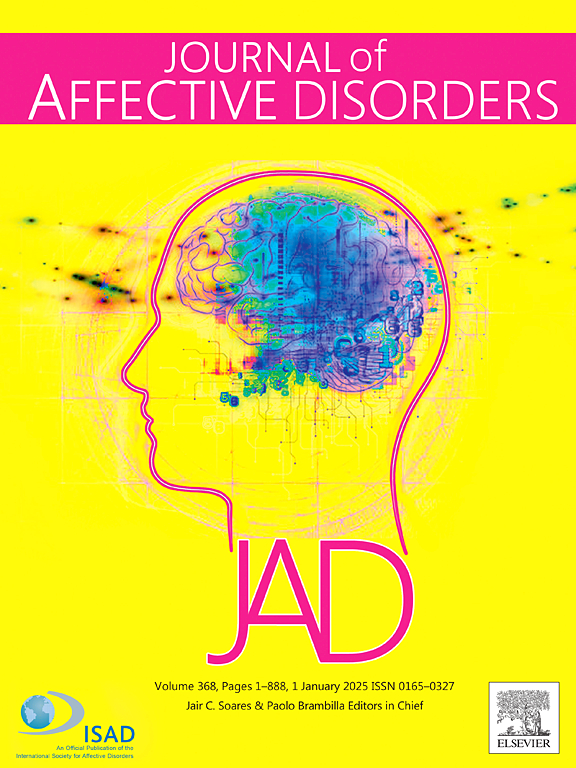中国青少年抑郁症患者面部情绪识别与非自杀性自伤的关系:一项多中心横断面研究
IF 4.9
2区 医学
Q1 CLINICAL NEUROLOGY
引用次数: 0
摘要
目的:青少年抑郁症与非自杀性自伤(NSSI)的发生率较高。探究自伤与面部情绪识别之间的关系对青少年抑郁症的早期干预具有重要意义。方法本研究采用多中心横断面设计(中国9个省14家精神病院)。采用患者健康问卷-9 (PHQ-9)和自残功能评估(FASM)分别评估抑郁和自伤。测试使用了中性、愤怒、厌恶、恐惧、快乐、悲伤和惊讶六种情绪。采用Spearman相关分析和二元logistic回归分析探讨自伤与情绪识别的关系。结果本研究共招募了1644名青少年抑郁症患者,其中76.2%(1252/1644)报告有自伤行为,且PHQ-9得分显著高于无自伤行为的青少年(p <;0.001)。选择“在皮肤上切割或雕刻”的方法更为常见(87.6%)。年龄曲线显示,各年龄组女生自伤发生率较高,且女生的自伤发生率峰值高于男生。与非自伤组相比,自伤组对厌恶情绪的识别准确率更高。此外,PHQ-9得分与中性认知显著相关(P <;0.001)、愤怒(P = 0.011)和快乐(P = 0.008)。PHQ-9得分(P <;0.001)和惊讶面部情绪识别评分(P = 0.026)与自伤行为有显著相关性。结论自伤在青少年抑郁症患者中较为常见,且自伤患者的情绪识别能力有所下降,尤其是对中性情绪、快乐情绪和愤怒情绪的识别能力有所下降。同样,抑郁进一步加剧了自伤的风险。本文章由计算机程序翻译,如有差异,请以英文原文为准。
Relationship between facial emotion recognition and non-suicidal self injury in adolescents with depression: A multicenter cross-sectional study from China
Object
Adolescent depression is highly co-occurring with non-suicidal self-injury (NSSI). Exploring the relationship between NSSI and facial emotion recognition is crucial for early intervention in adolescents with depression.
Methods
This study used a multi-center cross-sectional design (14 psychiatric hospitals in 9 provinces of China). The Patient Health Questionnaire-9 (PHQ-9) and Functional Assessment of Self-Mutilation (FASM) were used to evaluate depression and NSSI respectively. Six emotions including neutral, angry, disgusted, fearful, happy, sad and surprised were used for testing. Spearman correlation analysis and binary logistic regression analysis were used to explore the relationship between NSSI and emotion recognition.
Results
This study recruited 1644 adolescent depression patients, of whom 76.2 % (1252/1644) reported NSSI behavior and had significantly higher PHQ-9 scores than adolescents without NSSI behavior (p < 0.001). “Cut or carved on your skin” was more common in the choice of method (87.6 %). The age curve showed that girls have more NSSI in each age group, and the peak incidence of NSSI in girls was higher than that in boys. Compared with the non-NSSI group, the NSSI group exhibited higher accuracy in recognizing aversive emotions. In addition, PHQ-9 scores were significantly correlated with the recognition of neutral(P < 0.001), angry(P = 0.011), and happy(P = 0.008). Furthermore, PHQ-9 scores (P < 0.001) and Surprised facial emotion recognition scores (P = 0.026) showed significant correlations with NSSI behavior.
Conclusion
NSSI is common in adolescents with depression, and the emotional recognition ability of NSSI patients has decreased, especially in identifying neutral, happy, and angry emotions. Similarly, depression further exacerbates the risk of NSSI.
求助全文
通过发布文献求助,成功后即可免费获取论文全文。
去求助
来源期刊

Journal of affective disorders
医学-精神病学
CiteScore
10.90
自引率
6.10%
发文量
1319
审稿时长
9.3 weeks
期刊介绍:
The Journal of Affective Disorders publishes papers concerned with affective disorders in the widest sense: depression, mania, mood spectrum, emotions and personality, anxiety and stress. It is interdisciplinary and aims to bring together different approaches for a diverse readership. Top quality papers will be accepted dealing with any aspect of affective disorders, including neuroimaging, cognitive neurosciences, genetics, molecular biology, experimental and clinical neurosciences, pharmacology, neuroimmunoendocrinology, intervention and treatment trials.
 求助内容:
求助内容: 应助结果提醒方式:
应助结果提醒方式:


